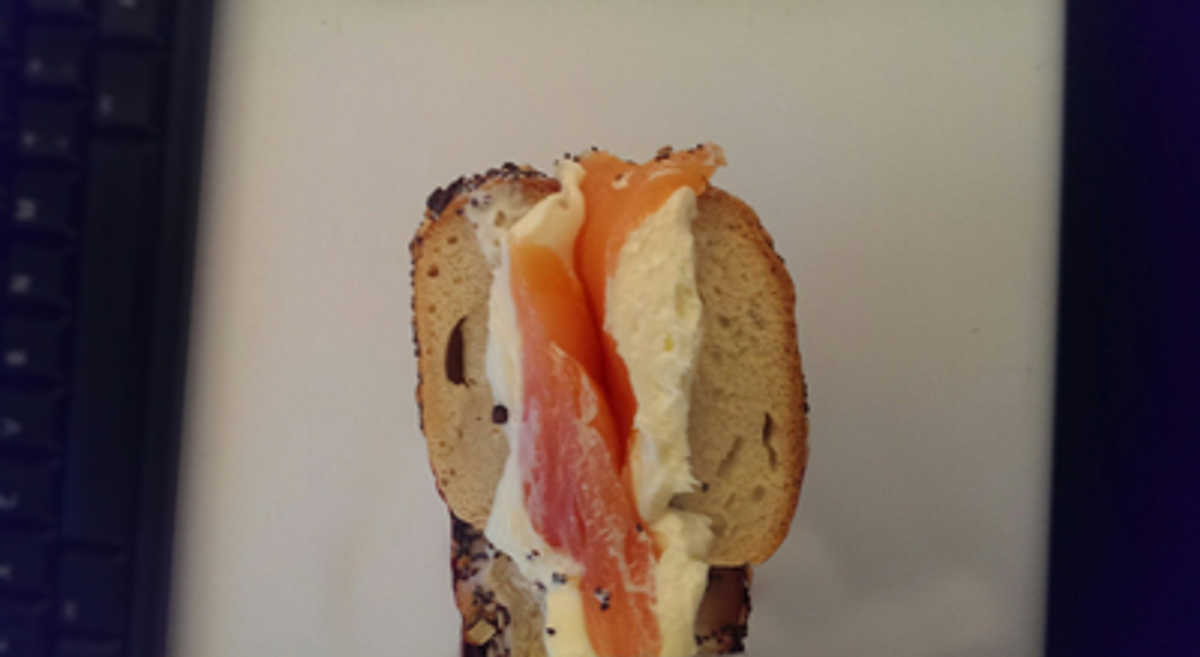A Lust for Lox
Herring curer Eric Moed bids farewell to New York with a photo exhibit about a fish of a different color




Eric Moed didn’t always love herring. “It actually started as pure disgust,” he told me recently. But after years of repulsion at the smell, he finally tried it. “My friend Huddy’s grandfather—a member of the last old-guard Modern Orthodox shul in Williamsburg and former Haganah fighter—shoved a piece of matjes in my face after services one morning,” he recalled. “He firmly said, ‘Eat it.’ I had no choice, and have been grateful ever since.”
“Not only was the herring delicious,” Moed said, “it shocked me with an energy that connected me to past generations of our people.”
In 2015, Moed went on to start—with friends—the Manhattan Herring Club, a group of Jewish men in their 20s and 30s who scout, eat, and cure New York’s best herring. (Benz’s in Crown Heights, Pomegranate in Flatbush, and the Hasidic store-bought “super-schmaltzy” at Raskin’s are Moed’s personal favorites; club co-founder Roni Jesselson, meanwhile, praised Russ & Daughters’ annual herring fest, calling the Lower East Side appetizing shop “the institution that sets the bar.”)
But Moed does more than taste herring. A Pratt Institute-trained architect, he is now also an artisan fish curer who’s been meeting for nearly a decade with other members in Manhattan, with spices from his uncle’s fourth-generation Crown Heights spice factory in tow, to cure their own herring. Jesselson’s herring concoctions, named after famous streets of the Lower East Side, range from “The Canal Street,” an Asian-fusion herring that is sweet and spicy with a hint of fish salt, to “The Ludlow,” a Spanish tapas-style spicy herring with shallots. “The Essex,” said Jesselson, “is a homage to what was once the pickle district and the famous Guss’ pickles that used to be on the street.” He and Moed added sangria and lemons for a twist. “It looks beautiful,” Jesselon continued, “and is lighter on the tongue than traditional pickled herring.”

Moed’s most recent batches of herring include matjes with kimchi, sesame oil, and cucumber; schmaltz with rosemary, citron, and balsamic reduction; and schmaltz in wasabi, Dijon, and truffle oil honey. “There hasn’t been much experimentation with herring recipes until recently,” Moed said, “so it’s very cool to be on the vanguard of reimagining this traditional food.”
After 10 years in Clinton Hill, Brooklyn, where he says he has “coordinated multiple fish-related kiddushes,” Moed is moving to Cambridge to attend the Harvard Graduate School of Design. To crown his time in Brooklyn, and mark an end to a decade of cured-fish devotion, he is hosting a photography show called Bagel Lust. “Where there is herring,” said Moed, “there is lox.”
The show, going up Aug. 8 at Ark House in Manhattan, will feature his original photos of “lox in various positions.” (Moed said: “I wanted to do something a little less traditional than a goodbye party.”) The show is a collection of photos he originally sent to Manhattan Herring Club members over the years, showing off New York delicacies. “In time, the portraits took on a more formal quality. They became a sort of documentation, a demarcation of events, and a detailing of my love for New York City’s foodstuffs.”
According to Moed the main inspirations for the show were Gary from Acme Smoked Fish and Georgia O’Keeffe.
***
When Moed moved to New York from Englewood, New Jersey, in 2007 to attend Pratt, he was president of campus Chabad and deeply involved in Jewish life. There he collected a group of like-minded herring-lovers. “Friends and I started enjoying this mysterious fish together, bonding over our shared backgrounds and a deep respect for Jewish tradition that many of us found elusive in other traditional practices,” he said. “In an age where we are all searching for experiential connectivity, this simple fish has provided me with a deep sense of belonging to our longstanding tradition and an equally profound feeling of pride about my Judaism.”
Jesselson recalled how the Manhattan Herring Club—which he termed “a movement of young men with old souls”—grew out of this informal circle of friends: “It began because a good friend and one of the founders, Jacob Frommer, wrote an inspirational article about his love for herring. [Some of us] reached out to Jacob and explained to him how we share this same love for herring,” which Jesselson calls “Jewish soul food.” “[We] said there’s more of us out here and we need to make an official club.”
When the group gathers, they cure or hunt or devour herring in all forms. “We eat herring together,” explained Moed, “go to herring-related events together, such as Fresh Catch Neuherring Festival each June at the Oyster Bar in Grand Central. We also simply email each other photos of herring that we’ve made or are about to eat.”
Club member Richard Norman recalled Rabbi Meir Soloveichik’s lecture on herring at an event called Herringfest last year at Shearith Israel in New York: “The act of eating herring connects us with thousands of years of history in a manner that is earned, not given. Like wine, beer, and dark chocolate, very few people are born herring lovers. Herring-love is attained through a combination of age and experience.”
“I like the fact that herring isn’t just something you can Google how to make,” Moed said. “Because if you mess up just a bit—like putting in one too many cloves (been there), your batch is ruined. You need to make it many times to get a feel for it.”
The preparation for Moed’s recent wedding, which had a small room dedicated to herring, included a meeting of the Manhattan Herring Club at member Richard Norman’s apartment. “The evening involved a sampling of a cross section of New York’s best herring offerings,” Norman said, including the preparation of several of their own blends. “Mezcal, jalapeno, and lime; homemade hot sauce; and horseradish, lemon, and dill proved to be three of the favorites.” Norman and Moed even met up in Europe on their respective honeymoons with their wives to scout herring and study its history.
“The club has grown, and it’s evident through the friendships that have formed,” said Jesselson. “People are asking me all the time to join. It’s ironic because we don’t meet weekly and we don’t have a membership platform. We joke around that to be initiated we have a hazing process that involves pickled herring being poured on your head. The truth is that it’s an old King Solomon test because like the baby who doesn’t get cut in half, we would never wastefully dump pickle herring over someone’s head.”
***
Bagel Lust is less about the past centuries of Jews curing fish and more about Moed’s personal memories of eating fish. “Bagel and lox was this food that kept me company through a decade in New York,” he said. “On Friday mornings that I make it to Acme Smoked Fish, I buy by the pound and eat with my hands.”
Lox and herring are part of what he calls “the holy trinity,” which also includes the shvitz—the communal baths. “All of these things go hand-in-hand together. They are about the lifestyle our grandparents lived, and are all connected,” he said. “Maybe we didn’t understand them when we were younger, but now they provide a reset from everyday life and serve as a link to the past—and a way to escape the present into another dimension.”
***
Like this article? Sign up for our Daily Digest to get Tablet Magazine’s new content in your inbox each morning.
Merissa Nathan Gerson is a writer, sex educator, and rape prevention advocate. She teaches Alternative Journalism at Tulane University in New Orleans.